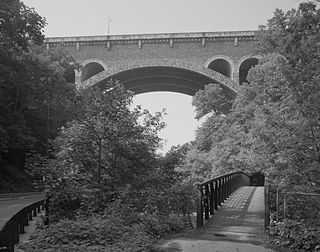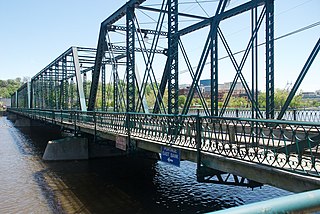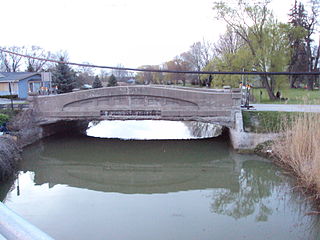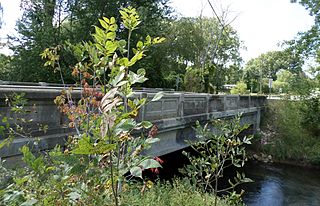
The Patterson Viaduct was built by the Baltimore and Ohio Railroad (B&O) as part of its Old Main Line during May to December 1829. The viaduct spanned the Patapsco River at Ilchester, Maryland. It was heavily damaged by a flood in 1866 and subsequently replaced with other structures.

The Union Arch Bridge, also called the "Cabin John Bridge", is a historic masonry structure in Cabin John, Maryland. It was designed as part of the Washington Aqueduct. The bridge construction began in 1857 and was completed in 1864. The roadway surface was added later. The bridge was designed by Alfred Landon Rives, and built by the United States Army Corps of Engineers under the direction of Lieutenant Montgomery C. Meigs.

The Division Avenue–Plaster Creek Bridge was a historic bridge in Grand Rapids, Michigan, carrying Division Avenue over Plaster Creek. It was listed on the National Register of Historic Places in 1999. The bridge was demolished and replaced in 2007.

The US 41–Fanny Hooe Creek Bridge is a highway bridge located on US Highway 41 (US 41) over the Fanny Hooe Creek about one mile east of Copper Harbor, adjacent to Fort Wilkins State Park, in Grant Township, Michigan. It was listed on the National Register of Historic Places in 1999.

The Wissahickon Memorial Bridge, originally called and still also known as the Henry Avenue Bridge, is a stone and concrete bridge that carries Henry Avenue over Wissahickon Creek and Lincoln Drive in Fairmount Park in Philadelphia, Pennsylvania.

The Gibraltar Road–Waterway Canal Bridge is a bridge located on Gibraltar Road over the Waterway Canal in Gibraltar, Michigan. It was listed on the National Register of Historic Places in 2000.

The Yosemite Valley Bridges are eight bridges in the Yosemite Valley of Yosemite National Park, most of them spanning the Merced River. Five of them were built in 1928, with the remainder built between 1921 and 1933. The bridges feature a concrete structure faced with local stone, in an elliptical or three-centered arch configuration. They are notable for their uniform character and for their conformance to tenets of the National Park Service rustic style. Design work for the seven newer bridges was by George D. Whittle of the San Francisco District Office of the U.S. Bureau of Public Roads for the National Park Service. Concrete bridges were chosen at the urging of Thomas Chalmers Vint of the Park Service, in lieu of alternative designs for steel truss bridges, or suspension bridges suggested by the park superintendent.

The M-28–Sand River Bridge is a bridge located on M-28 over the Sand River in Onota Township, Michigan. It was listed on the National Register of Historic Places in 1999.

Bridge No. 1860, also known as the Samson Occom Bridge, is a fieldstone arch bridge in Montville, Connecticut, United States. Constructed by the Connecticut State Highway Department in 1936 as a Works Progress Administration project, it is located on Mohegan tribal land in an area that was once a part of Fort Shantok State Park. The bridge carries traffic from Massapeag Side Road over the Shantok Brook, a tributary of the Thames River. Spanning 12 feet (3.7 m) across the brook, the bridge's arch rises about 6 feet (1.8 m) above the water. According to a 2011 Connecticut Department of Transportation report, it carries 1,100 vehicles per day. Samson Occom Bridge was listed on the National Register of Historic Places in 1993.

The Sixth Street Bridge is a four-span, wrought iron bridge that crosses the Grand River in Grand Rapids, Michigan. It is a Michigan State Historic Site and is listed on the National Register of Historic Places. Built in 1886, it is the longest and oldest metal truss bridge in Michigan.

The Lincoln Road–Pine River Bridge, also known as the Riverdale Bridge, was a bridge located on Lincoln Road over the Pine River near Seville, Michigan. The architect behind the Lincoln Road–Pine River Bridge was the Michigan State Highway Department and its builder was Walter Willets. The bridge is notable for being a large early example of an arched through girder bridge in Michigan, and for sitting on substantially skewed abutments. It was listed on the National Register of Historic Places in 1999.

The Stony Creek Bridge is a bridge located on a private road over Stony Creek in Olive Township, Clinton County, Michigan. It was listed on the National Register of Historic Places in 1999. It is the last example of a queen post truss bridge extant in Michigan.

The Gilsum Stone Arch Bridge carries Surry Road over the Ashuelot River in Gilsum, New Hampshire. Built in 1862–63, it is one of the highest stone arch bridges in the state. It has a span of 47 feet 8 inches (14.53 m), and an average height over the river of 36 feet 6 inches (11.13 m). The roadway is 43 feet 6 inches (13.26 m) above the riverbed. It stands on the site of four previous bridges, where the river passes through a deep gorge. The previous bridge was also a stone arch bridge, which was built in 1860 and collapsed a few months later. It was designed by William Leonard Kingsbury, a local official; its builders are not known because the town's records were destroyed in a fire. The present bridge's vault is carefully constructed from dry-laid granite voussoirs that were shaped for a very precise fit, with larger stones at the lower ends of the arch, and a smaller ones at the crown. Some of the stones were left with rough surfaces, while others were hammered smooth.

The West Sixth Street Bridge is a historic stone arch bridge in downtown Austin, Texas. Built in 1887, the bridge is one of the state's oldest masonry arch bridges. It is located at the site of the first bridge in Austin, carrying Sixth Street across Shoal Creek to link the western and central parts of the old city. The bridge was added to the National Register of Historic Places in 2014.

The Vernier Street–Swan Creek Bridge was a historic bridge carrying Vernier Street over Swan Creek in Ira Township, Michigan. It was listed on the National Register of Historic Places in 2000. It was at one time one of the oldest remaining curved-chord though girder bridges, a design unique to the state of Michigan. The bridge was demolished in 2014.

The Jeddo Road–South Branch Mill Creek Drain Bridge is a bridge carrying Jeddo Road over the south branch of the Mill Creek Drain in Brockway Township, Michigan. It was listed on the National Register of Historic Places in 2000.

The Powers Highway-Battle Creek Bridge is a bridge that formerly carried Powers Highway over Battle Creek in Brookfield Township, Michigan. It was listed on the National Register of Historic Places in 2000. The bridge is a double-intersection Warren truss, a design noted for its extremely lightweight members and low cost. It is the only known example of its type in Michigan.

The Derby Street-Grand Trunk Western Railroad Bridge is a bridge carrying Derby Street over the Grand Trunk Western Railroad in Birmingham, Michigan. It was listed on the National Register of Historic Places in 2000.

The M-50–Sandstone Creek Bridge, also known as th Tompkins Bridge, is a road bridge carrying M-50 over Sandstone Creek in Tompkins Township, Michigan. It was listed on the National Register of Historic Places in 2000.

The Mill Street–South Branch Raisin River Bridge is a bridge carrying Mill Street over the South Branch of the River Raisin in Brooklyn, Michigan. It was listed on the National Register of Historic Places in 2000.























